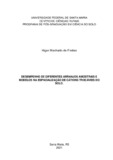| dc.creator | Freitas, Higor Machado de | |
| dc.date.accessioned | 2021-08-19T12:55:21Z | |
| dc.date.available | 2021-08-19T12:55:21Z | |
| dc.date.issued | 2021-04-16 | |
| dc.identifier.uri | http://repositorio.ufsm.br/handle/1/21998 | |
| dc.description.abstract | Soil sampling for the mapping of its properties can be performed by a variety of arrangements with different levels of complexity. Considering the importance of exchangeable soil cations for crops, it is necessary to describe their distribution in space and time in the different agroecosystems. Among the variety of sampling arrangements used in the digital mapping of exchangeable soil cations, the Regular grid sampling (R), the Spatial Coverage sampling (S) and the Latin Conditioning Hypercube sampling (cLHS) stand out. Therefore, the objective of this research is to test whether the performance of the cLHS sampling arrangement that uses environmental covariates, when compared to the regular grid and spatial coverage arrangements, will increase the accuracy in the digital mapping of exchangeable soil cations, carried out by two methods of spatial modeling (geostatistics and mixed linear model), in an area of grain cultivation under central pivot irrigation. The study area covers 160 hectares. For the predictions of the spatial distribution of the exchangeable cations of the soil, the three sampling arrangements, regular grid, spatial coverage and conditioned Latin hypercube were used. The spatial predictions made in the ArcMap® software were used, using Krigagem, and also, mixed linear model in the software R. For the geostatistics the sampling arrangement that presented better accuracy in the prediction of Al and K was the mesh. R, the lowest predictive performance was presented in the S grid. In the case of Ca, the sampling arrangement that had the highest performance was that of the R mesh and the lowest was of the cLHS mesh. Finally, for Mg, the best performance was the S mesh, and the lowest performance was the R mesh. The sampling arrangement that showed the best accuracy in the prediction of exchangeable soil cations using the mixed linear model was the cLHS mesh model. It was observed that the mesh S obtained a good predictive performance, while, the lowest performance was of the R mesh sampling arrangement. Thus, the Hipercubo Latino Conditioned sampling arrangement proved to be superior to the other tested arrangements. | eng |
| dc.description.sponsorship | Coordenação de Aperfeiçoamento de Pessoal de Nível Superior - CAPES | por |
| dc.language | por | por |
| dc.publisher | Universidade Federal de Santa Maria | por |
| dc.rights | Attribution-NonCommercial-NoDerivatives 4.0 International | * |
| dc.rights.uri | http://creativecommons.org/licenses/by-nc-nd/4.0/ | * |
| dc.subject | Mapeamento digital de solos | por |
| dc.subject | Agricultura de precisão | por |
| dc.subject | Pedometria | por |
| dc.subject | Digital soil mapping | eng |
| dc.subject | Precision agriculture | eng |
| dc.subject | Pedometry | eng |
| dc.title | Desempenho de diferentes arranjos amostrais e modelos na espacialização de cátions trocáveis do solo | por |
| dc.title.alternative | Performance of different sample arrangements and models in the spacialization of soil exchangeable cations | eng |
| dc.type | Dissertação | por |
| dc.description.resumo | A amostragem do solo para o mapeamento de suas propriedades pode ser realizada por uma variedade de arranjos com diferentes níveis de complexidade. Dada a importância dos cátions trocáveis do solo para a produção vegetal, faz-se necessária a descrição da sua distribuição no espaço e no tempo nos diferentes agroecossistemas. Dentre os diversos arranjos amostrais empregados no mapeamento digital de cátions trocáveis do solo destacam-se a amostragem de grade Regular (R), a amostragem de Cobertura Espacial (S) e a amostragem de Hipercubo Latino Condicionado (cLHS). Portanto, o objetivo do presente trabalho é testar se o desempenho do arranjo amostral cLHS que utiliza covariáveis ambientais, quando comparado aos arranjos de grade regular e de cobertura espacial, aumentará a acurácia no mapeamento digital de cátions trocáveis do solo, realizados por dois métodos de modelagem espacial, sendo eles, a geoestatística e o modelo linear misto, numa área de cultivo de grãos de 160 hectares sob irrigação por pivô central. Para as predições da distribuição espacial dos cátions trocáveis do solo, foram utilizados os três arranjos de amostragem (R, S e cLHS). A predição espaciai realizada pela krigagem foi desenvolvida no software ArcMap®, enquanto a predição pelo modelo linear misto foi desenvolvida no software R. Para a geoestatística o arranjo amostral que apresentou melhor acurácia na predição do Al e do K foi o da malha R, o menor desempenho preditivo foi apresentado na malha S. No caso do Ca, o arranjo amostral que teve maior desempenho foi o de malha R e o menor foi da malha cLHS. Por fim, para o Mg, o melhor desempenho foi o da malha S, e o menor desempenho foi da malha R. O arranjo amostral que apresentou melhor acurácia na predição dos cátions trocáveis do solo utilizando o modelo linear misto foi o da malha cLHS. Observou-se que a malha S obteve um bom desempenho preditivo, enquantoa malha R apresentou o menor desempenho preditivo. Assim, o arranjo amostral do Hipercubo Latino Condicionado mostrou-se superior aos demais arranjos testados. | por |
| dc.contributor.advisor1 | Pedron, Fabrício de Araújo | |
| dc.contributor.advisor1Lattes | http://lattes.cnpq.br/6868334304493274 | por |
| dc.contributor.referee1 | Schenato, Ricardo Bergamo | |
| dc.contributor.referee2 | Cancian, Luciano Campos | |
| dc.creator.Lattes | http://lattes.cnpq.br/9297886237642650 | por |
| dc.publisher.country | Brasil | por |
| dc.publisher.department | Agronomia | por |
| dc.publisher.initials | UFSM | por |
| dc.publisher.program | Programa de Pós-Graduação em Ciência do Solo | por |
| dc.subject.cnpq | CNPQ::CIENCIAS AGRARIAS::AGRONOMIA::CIENCIA DO SOLO | por |
| dc.publisher.unidade | Centro de Ciências Rurais | por |



